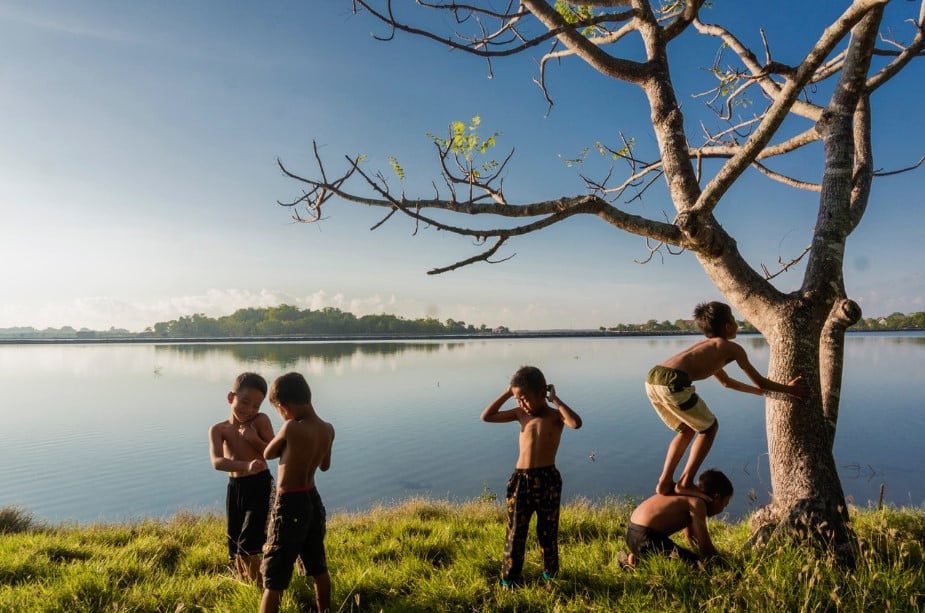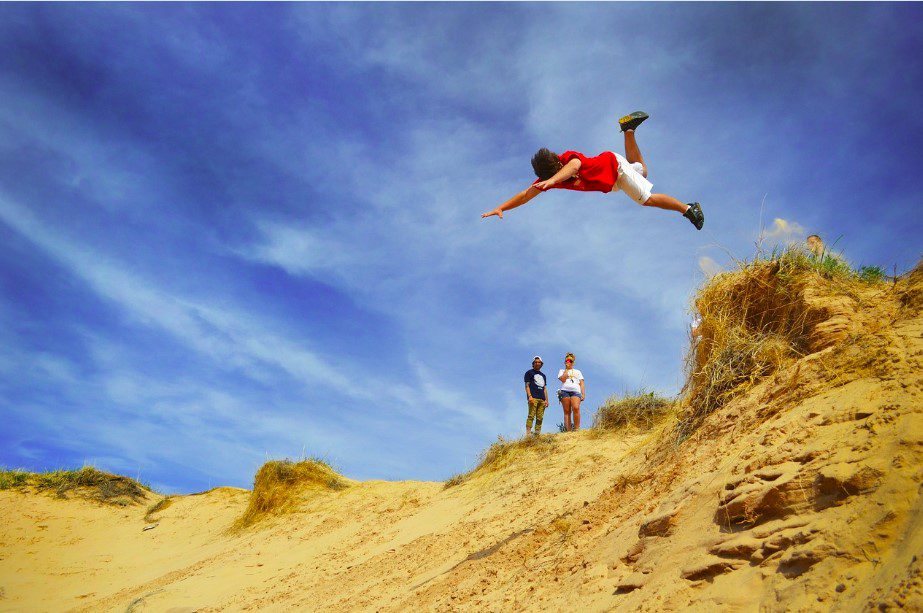Risky play is a type of play that involves some level of physical risk or perceived danger. Examples of risky play for children include climbing trees, jumping from heights, playing with sharp objects, or exploring unfamiliar terrain.
While parents and caregivers may instinctively try to protect children from such activities, research has shown that engaging in risky play can be beneficial for children’s development in various ways.
Benefits of risky play:

Physical Development:
Risky play can help children develop their gross motor skills, balance, and coordination. It can also contribute to the development of muscle strength and flexibility. For example, climbing a tree requires the use of multiple muscles and body parts. This can help improve children’s overall physical fitness.
Cognitive Development:
Engaging in risky play can also enhance cognitive development. It allows children to assess and manage risks, which helps develop problem-solving skills.
When children climb a tree or navigate a challenging terrain, they need to assess the risks and make decisions about how to proceed. This type of cognitive development is critical for children as it helps them develop their decision-making and risk assessment skills.
Confidence and Resilience:
Risky play can help children develop a sense of mastery and achievement, as well as a sense of self-confidence and resilience. When children engage in play and successfully navigate a challenge or obstacle, they feel a sense of accomplishment. This sense of mastery can then translate into a more generalized sense of confidence and resilience that can help children tackle other challenges in their lives.
Social Skills:
Engaging in risky play can also help children develop important social skills. For example, when children play together on a playground, they must work together, communicate effectively, and develop empathy for others. These skills are essential for children as they develop social relationships and navigate the world around them.
Risk management in risky play:

It is important to note that the level of risk involved in play should be appropriate for the child’s age and developmental stage.
Parents and caregivers must take appropriate safety measures to ensure that children are not exposed to unnecessary danger. Ultimately, a balanced approach to risky play can help children develop important skills and experiences while staying safe and healthy.
Examples of appropriate risk management strategies include:
Supervision:
Adults should supervise children to ensure they are safe. While supervision does not eliminate all risks, it does provide an opportunity for adults to intervene if necessary.
Safety Equipment:
Children should use appropriate safety equipment when engaging in risky play. For example, helmets should be worn when riding a bike or scooter, and safety nets should be used when trampolining.
Boundaries:
Boundaries should be established for risky play activities to ensure that children stay within safe limits. For example, if children are playing in a park, adults should establish boundaries for where they can play and where they cannot.
Education:
Children should be educated about the risks associated with certain play activities. For example, they should understand the risks associated with climbing trees and how to do it safely.
Challenges of risky play:

One of the challenges of risky play is that it can be difficult for parents and caregivers to strike the right balance. It is difficult to know when to allow children to engage in risky play and ensuring they are safe.
Some parents and caregivers may be overly protective and restrict their children’s opportunities from venturing in playtime, while others may be too permissive and allow their children to engage in activities that are too risky.
Another challenge is that some children may be more prone to risk-taking behavior than others.
While engaging in risky play can be beneficial, it is important to recognize that some children may be more impulsive or less cautious than others. Parents and caregivers need to be aware of these individual differences and tailor their approach to play accordingly.
Research on risky play:
Research has shown that engaging in risky play can be associated with numerous benefits for children’s development.
For example, a study published in the International Journal of Environmental Research and Public Health found that children who engaged in more outdoor risky play had better physical fitness, motor coordination, and cognitive functioning than children who engaged in less challenging outdoor play.
The study also found that risky play was associated with higher levels of self-esteem and resilience.
Additionally, children may experience feelings such as enjoyment, pride, achievement, and good self-esteem when they master new challenges, adding to the potential rewards of engaging in risky play.
NCBI
Another study published in the Journal of Child Psychology and Psychiatry found that children who engaged in more risky play had better emotional regulation skills than those who did not.
The study also found that risky play was associated with higher levels of social competence and fewer behavioral problems.
While there are many benefits to risky play, it is important to note that not all risky play is equal. Risky play with sharp objects or engaging in unprotected contact sports, can be particularly dangerous and increase the risk of injury.
Additionally, it is important to consider the cultural and socioeconomic factors that may influence children’s opportunities for risky play. For example, children living in urban environments may have fewer opportunities for outdoor play and exploration than children living in rural areas.
Children from low-income families may also have limited access to safe outdoor play spaces and equipment. These factors can limit children’s opportunities for risky play and may contribute to disparities in children’s development.
Conclusion:
In summary, risky play is a type of play that involves some level of physical risk or perceived danger. Engaging in risky play can be beneficial for children’s physical, cognitive, emotional, and social development, as well as their overall well-being.
However, it is important for parents and caregivers to use their best judgment when assessing the risks associated with different types of play and to take appropriate safety measures to ensure that children stay safe.
By providing children with opportunities for appropriate risky play, we can help them develop important skills and experiences that will serve them well throughout their lives.




Leave a Reply